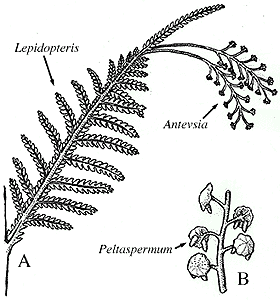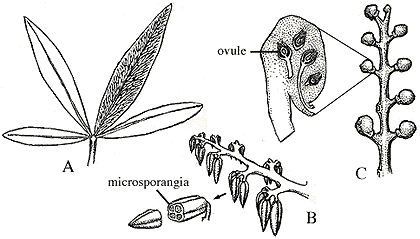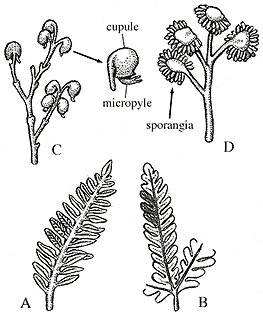![[Laboratory X - Anthophytes, Glossopterids and Others]](CupD/CupfontB.jpeg)
![[Laboratory X - Anthophytes, Glossopterids and Others]](CupD/CupfontB.jpeg)
The peltasperms are described from the Late Permian to the Late Triassic of South Africa and Europe, including the Russian platform and Greenland. It has been possible to assemble the whole plant from associated organs (stem fragments, leaves, ovulate structures, pollen organs) due to the occurrence of blister-like sub-epidermal swellings and a certain stomatal morphology on all parts. The plant is alternatively called Lepidopteris after the foliage, and Peltaspermum, based on the megasporophyll. Since we don't have any material for this group, refer to available references to get a better understanding of the morphology of this plant.
Lepidopteris is a bipinnate frond whose pinnules resemble some species of Alethopteris (Figure 10.4). However, Lepidoteris fronds typically have so-called intercalary pinnules along the rachis between the primary pinnae, and are covered with the characteristic blisters mentioned above.

|
Figure 10.4: Foliage and reproductive structures of the peltasperms. (A) Lepidopteris foliage with attached pollen organ, Antevsia. (B) Peltaspermum ovulate structures borne on a pinnate axis. |
The microsporophyll of Lepidopteris (Antevsia) has been reconstructed as a pinnate axis with short branches bearing clusters of small elongate pollen sacs fused at the base. The ovulate structures, Peltaspermum, are umbrella-like discs that bore ovules in a ring on the underside (Figure 10.4). The discs are in their turn pinnately arranged around an axis. Like in the corystosperms, the ovules have curved micropylar beaks. It has therefore been proposed that the cupules of Caytonia and the corystosperms evolved from similar structures through recurvation of the disc margins until it encloses the ovule(s). Is this hypothesis consistent with the cladogram in the Virtual Laboratory? Explain. What would be an alternative explanation?
Caytonia
Caytonia is better known that any other Mesozoic seed plant and had a wide distribution; it has been described from Triassic to Cretaceous localities in most of today's Northern Hemisphere. Caytonia is believed to have been a small tree, based on association of foliage with woody axes, and there is evidence that at least some members of the group grew in periodically waterlogged habitats.
Initially, Caytonia was regarded as a very close relative to the flowering plants due to its remarkable reproductive features. The megasporophyll (organ-genus Caytonia) is an axis bearing sub-opposite pairs of stalked, rounded cupules (Figure 10.5). Each cupule is recurved, has a lip-like projection near the point of attachment, and contains several ovules arranged in a curved row with their micropyles facing the cupule opening. The micropyles of the ovules are connected with the outer lip of the cupule via a canal. The discovery of what was incorrectly interpreted as pollen tubes in association with the lip-like projection, and the fleshy character of the cupule itself, led some workers to conclude that Caytonia represented a fruit (carpel) with many seeds. Further studies showed that the fruit-like nature of Caytonia cupules was a case of analogy rather than homology. Note that the ovules of Caytonia do not possess a double integument!

|
| Figure 10.5: Caytonia. (A) Sagenopteris foliage; (B) Caytonanthus microsporophyll with synangia; (C) Caytonia megasporophyll and longitudinal section of cupule showing ovule position and orientation.
|
The pollen-producing organ of Caytonia, Caytonanthus (Figure 10.5), consists of synangial units of four fused, elongate microsporangia that show some resemblance to both the pollen organ of Medullosa and angiosperm anthers. The synangia are arranged along an axis, which probably represent a modified pinnate microsporophyll.
The foliage of Caytonia was known from several localities long before any reproductive structure had been found. Sagenopteris consist of two to four palmately arranged lanceolate leaflets with a distinct mid-vein. The epidermal structure of these leaflets shows some similarities to that of flowering plants.
The small group of plants known as the corystosperms, Pteruchus, are found in the Triassic of South Africa, Australia, Argentina, Tasmania, Antarctica and India (Figure 10.6). Indeed, judging by the prevalence of its foliage (Dicroidium) it was one of the major plant taxa in the Triassic ecosystem of Gondwana and is an important index fossil and biogeographic marker. Moreover, a recent discovery (Taylor & Archangelsky, 1985) suggests that come of the corystosperms may have persisted into the Cretaceous -- contemporaneous with early angiosperms. The corystosperms are believed to have been small and woody. They produced several types of foliage all characterized by pinnate leaves with open dichotomous venation.

|
Figure 10.6: Corystosperms. (A) Dicroidium foliage; (B) Pachypteris foliage; (C) Umkomasia megasporophyll with cupules and close up of cupule showing bifurcating micropyle; (D) Pteruchus microsporophyll. |
Umkomasia is the weird and unique ovulate structure of the corystosperms, and what potentially links it to the angiosperms (Figure 10.6) (VG 1:7). The megasporophyll is an axis with branches borne in axils of bracts. The branches carry opposite pairs of stalked, recurved, helmet-like cupules, which should remind you of the arrangement of Caytonia. However, in the case of Umkomasia, each cupule contains only one ovule. In addition, the curved micropyle of the ovule protrudes beyond the cupule (compare with Caytonia). For this reason some paleobotanists regard Umkomasia as an intermediate stage in the evolution of a closed cupule from an open one. Does this sound like a reasonable scenario to you, keeping the Cretaceous date of some corystosperms in mind?
The pollen organ of the corystosperms, Pteruchus, are alternately borne microsporophylls along a short axis. The microsporangia are arranged in clusters on the abaxial side of flattened circular or elliptical lamina on the distal end of the microsporangiophylls (VG 1:8).
Leaves that have been found in association with the reproductive structures typical of the corystosperms are primarily Dicroidium (VG 1:9), Pachypteris (Figure 10.6)(VG 1:10), and Stenopteris; Dicroidium is the most common. All of these foliage forms are planate pinnate fronds, frequently with open venation.
The preceding plants form a grade between the lineages considered in Lab 9 (conifers, Ginkgo and Cordaites) and the flowering plants and their kin. The remainder of the groups we will consider in this lab have more clearly resolved relationships and form a clear monophyletic group.
![[Previous Page]](../VPLimg/Back.jpeg) |
![[Title Page]](CupD/Cupbutt.jpeg) |
![[Glossary]](../VPLimg/Glossbutt.jpeg) |
![[Range Chart]](../VPLimg/Rangebutt.jpeg) |
![[Geologic Time Scale]](../VPLimg/timesbutt.jpeg) |
![[Next Page]](../VPLimg/Forward.jpeg) |

